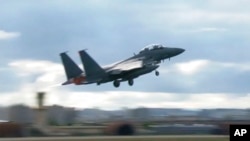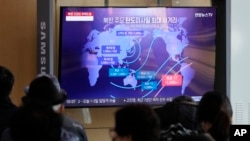South Korea scrambled fighter jets Friday after detecting 180 North Korean military flights near the border, South Korea’s military said, as tensions on the Korean Peninsula continued to escalate.
The North Korean aircraft were detected in multiple inland areas and both of North Korea’s coasts for about four hours starting about 11:00 a.m. local time, said South Korea’s Joint Chiefs of Staff.
In response, South Korea’s military says it urgently deployed 80 fighter jets, including the F-35A stealth fighter. About 240 U.S. and South Korean aircraft continued large-scale aerial drills, South Korea’s military added.
Earlier Friday, South Korea announced the so-called Vigilant Storm aerial exercise would run through Saturday, a day later than initially planned, in response to North Korean provocations.
Since Wednesday, North Korea has launched 30 missiles, including some that triggered air raid alerts and emergency shelter orders in South Korea and Japan.
North Korea is upset at the U.S.-South Korea exercises, which have been expanded in response to recent North Korean weapons tests and other threats.
Pyongyang views the drills as preparations to invade and often uses them as an occasion to ramp up tensions, creating a sense of crisis on the Korean Peninsula.
Air exercises
That dynamic could help explain North Korea’s decision to deploy so many aircraft Friday – a move that could reveal sensitive information about how North Korea’s air force functions under extraordinary conditions, says Daniel Pinkston, a Seoul-based international relations professor at Troy University.
“But the air power balance is so unfavorable to them, that maybe they don't care about revealing info about this type of activity,” said Pinkston, who has written about North Korea’s air force.
By some estimates, North Korea’s military has between 600-700 aircraft, but most are very old and not thought to be well-maintained, due to cost factors.
“The pilots get so little flight training that this exercise accomplishes some flight training objectives,” Pinkston told VOA.
Last month, North Korea also sent about 10 warplanes so close to the border that it triggered an automatic operational response by South Korea’s air force.
It’s not clear how close the North Korean planes got to the inter-Korean border Friday. But Seoul officials said the aircraft did not cross the Tactical Action Line, or TAL.
The TAL is a boundary north of the border that was set by the South Korean military to give sufficient time to respond to North Korean provocations.
North Korea has not commented on any of its military moves over the past several days but has warned of “powerful follow-up measures” in response to the U.S.-South Korea exercises.
US response
The United Nations Security Council will meet Friday to discuss the North Korean launches, at the request of countries including the United States, multiple diplomats told VOA.
In Washington, the South Korean and U.S. defense chiefs vowed Thursday to increase their defense posture in response to North Korea’s tests.
South Korean National Defense Minister Lee Jong-sup, speaking alongside his U.S. counterpart, Defense Secretary Lloyd Austin, said the U.S. agreed to deploy strategic assets "to the level equivalent to constant deployment.”
South Korea has urged the United States to send more nuclear-capable warplanes and ships to the region, as North Korean leader Kim Jong Un ramps up missile tests and warns of his ability to conduct tactical nuclear strikes against the South.
“Any nuclear attack against the United States or its allies and partners, including the use of non-strategic nuclear weapons, is unacceptable and will result in the end of the Kim regime,” Austin said, according to a joint statement issued after the meeting at the Pentagon.
The two leaders also visited a U.S. air base just outside Washington, where they posed with B-1B and B-52 bombers, the latter of which is nuclear-capable. During past cycles of tension, the U.S. has run those bombers across the Korean Peninsula in a show of force.
On Thursday, a senior North Korean official blamed Washington and Seoul for bringing tensions to an “uncontrollable phase.”
“The U.S. and South Korea will get to know what an irrevocable and awful mistake they made,” said the statement by Pak Jong Chon, a senior official in North Korea’s ruling Workers’ Party.
North Korea has fired about 60 ballistic missiles this year, a record by far. Its launches this week have been among its most provocative yet.
The launches created especially tense situations in northern Japan early Thursday. In Miyagi, Yamagata, and Niigata prefectures residents were warned to take shelter indoors.
Japanese television broadcasts were also interrupted by emergency alerts, which initially said a North Korean missile flew over and past Japanese territory. However, defense officials later retracted that claim, saying they lost track of the missile while it was flying over the sea.
North Korea aimed three of Wednesday’s launches toward South Korea, triggering television alerts in the South and air raid sirens on an island off the coast.
In response, South Korea’s military on Wednesday said its warplanes launched three missiles north of the de facto sea border to demonstrate South Korea’s “capability and readiness to strike the enemy with precision.”
Neither country had sent missiles across the Northern Limit Line – the countries’ Yellow Sea demarcation line – since the end of the 1950-53 Korean War; on Wednesday they both did within hours of each other.
VOA United Nations correspondent Margaret Besheer contributed to this story.












